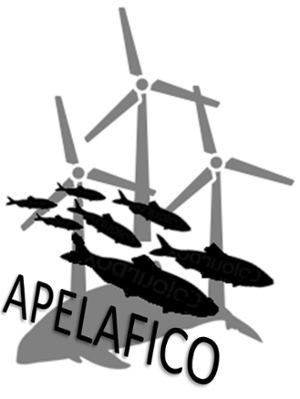Research project
APELAFICO: Acoustic ecology of PELAgic FIsh COmmunities: A study into the effects of construction and operation of wind farms
Do offshore windfarms affect the local biodiversity of the pelagic fish community and are fish deterred or attracted by sounds?
- Duration
- 2021 - 2025
- Contact
- Hans Slabbekoorn
- Funding
-
 NWO - Nationale Wetenschapsagenda (Dutch Research Agenda)
NWO - Nationale Wetenschapsagenda (Dutch Research Agenda)
-
 Rijkswaterstaat - Ministerie van Infrastructuur en Milieu
Rijkswaterstaat - Ministerie van Infrastructuur en Milieu
- Partners
- Elisabeth Debusschere (VLIZ, Belgium)
- Lise Docksaeter-Sivle (IMR, Norway)
- Michael Ainslie (JASCO, Germany)
- Benoit Berges (WMR, the Netherlands)
- Alain Norro (RBINS, Belgium)

Description
APELAFICO concerns an interdisciplinary project with fundamental and applied aspects. We will collect data on density and diversity of pelagic fish in and around offshore windfarms in association with acoustic conditions during the construction and operation of windfarms. We will also zoom in on the fate of fish in the direct vicinity of pile driving and test acoustic deterrence as mitigation strategy.
Pelagic fish communities play a key role in the food chain and are of large commercial value. Accumulation of wind farm clusters such as at the Dutch-Belgian border may alter large areas that are important to pelagic species. Effects on the pelagic community are likely complex and not necessarily just negative or positive for density and diversity. However, offshore windfarms are spreading worldwide and still very little is known about the impact on pelagic fish communities.

Pelagic fish species often occur in cohort structured schools, with older individuals and larger schools becoming more independent of substrate and shallow water. The variety in size and patchy occurrence of pelagic fish schools makes them a dynamic and key factor in assessments of ocean health status. We will use bottom-mounted echosounders to determine the presence and schooling behaviour of pelagic fish.

Offshore windfarms also generate sound. In the construction phase, vessel and construction activities, and pile driving in particular, generate high amplitude, repeated, impulsive sounds events. In the exploitation phase, sound levels are lower. Fishes close to pile driving sounds may become deaf, injured, and even get killed. Sound events of moderate level can deter, disturb, and mask, but can thereby also protect marine animals against exposure to extreme sounds.
The principle of acoustic herding for conservation has been applied with acoustic deterrent devices for marine mammals and is now also required by law for fishes prior to pile driving. However, current fish deterrent devices have no proven functionality under field conditions and in this project we will improve and test the current state of the art.

